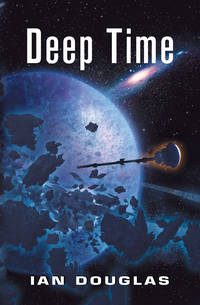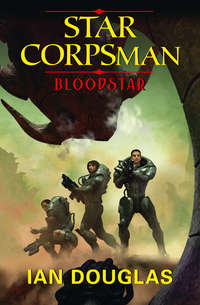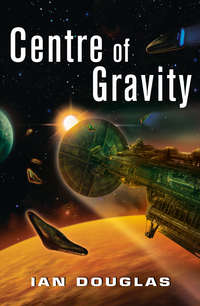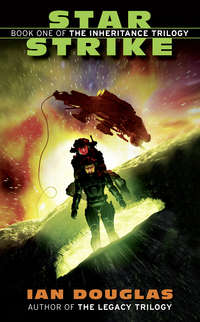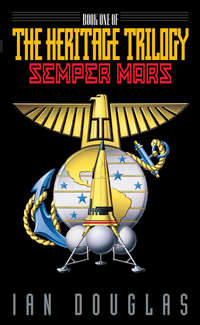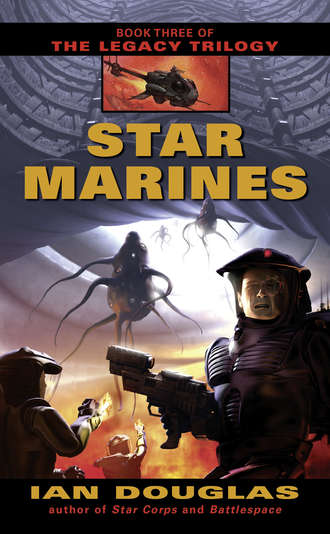
Полная версия
Star Marines
What the hell was going on up there?
Mars Military Training Command
Stickney Base,
Phobos
1455 hrs, local
“This way, General, if you please.”
Garroway followed the young Navy lieutenant commander down a corridor with rounded, padded walls and four sets of handrails placed to either side, and above and below. The surface gravity of Phobos was minute; he weighed only a few ounces here, and he could make his way with considerable speed by pulling himself along hand-over-hand. The tunnel was crowded with military personnel of all services, and a number of civilians as well, all moving in the same direction.
“Just where in hell are we going, commander?” Garroway demanded.
“Orders, sir,” she replied. “From Earth! We’re evacuating Phobos.”
“So I gather. Why?”
“Damfino … uh, sorry, sir. I don’t know. But hurry! Please!”
Like red cells crowding through a blood vessel, the crowd followed a bend in the passageway leading left, then took a new tunnel that opened in the overhead of the old. Hauling himself up against the moonlet’s feeble gravity, he soon entered a massive airlock, and recognized one of the main docking connectors giving access to the labyrinth of tunnels and rooms honeycombing Phobos. Two scared-looking naval personnel clung to the bulkheads, waving people on, and up.
Moments later, Garroway followed his escort into the main lock of the armed transport Commodore Edward Preble.
His escort threaded her way ahead through the press of bodies, leading him at last to a compartment marked COMMUNICATIONS CENTER.
“They wanted you in here, sir,” she told him. “Go to Channel Fifteen, and identify yourself. Good luck!”
“Thank you, Commander …”
But she was already gone.
Preble’s comm center was a circular room with several oversized, sharply reclined chairs set around the room’s perimeter, half of them already occupied by naval officers. Garroway picked an empty seat, lay down, and brought the palm of his hand into contact with the electronic pickup in the armrest.
“Channel Fifteen,” he said in his mind. “Garroway, Clinton. Major General. Service number seven-seven-six, three-one—”
A window opened in his mind.
He recognized the face looking out at him—an old friend, Major General Ronald Edison, CO of the Marine Interstellar Expeditionary Command, and Garroway’s boss. “Good morning, Clint,” Edison said. The older man’s eyes flicked to a point offcamera, then back. “At least, it’s morning here. We have … a problem.”
Garroway didn’t respond. Edison was on Earth—probably in his office in the Pentagon, in Arlington, Virginia—and with the current respective positions of Earth and Mars, a lasercom signal took over fourteen minutes to pass one-way from one to the other. Edison had transmitted this message almost a quarter of an hour earlier.
“Thirty minutes ago, we received an emergency tight-beam radio communication from the Titan-class monitor Prometheus. The message was transmitted from near Saturn at zero-four-forty-eight hours Zulu—that’s just over an hour and a half ago. Here is the message in its entirety.”
The general’s face vanished, replaced by a sight Garroway knew, but had hoped never to see in his lifetime—a rapidly growing oval of pure gold, reflecting the light of a distant sun as it approached the camera. The image shifted to a different angle, this one taken from a remote drone some distance away and off to one side. The golden oval was only the end-on view of an immense vessel, shaped like a flattened needle, slim, but titanic in bulk and mass. Flickering alphanumerics on the border of the noumenal image, together with computer-generated schematics, suggested a vessel nearly two kilometers long, hundreds of meters thick, and massing somewhere in the tens of millions of tons.
“The ship appears to be identical to the one we encountered at Sirius in 2170!” a new voice was saying. Static hissed and blasted, distorting the words. The intruder must be putting out some sort of high-energy field, interfering with the transmission. “We have just lost contact with the High Guard patrol frigate Rasmusson, which … well, their last known position would have been pretty close to this monster’s line of approach.
“It’s coming from just about right ascension six hours, forty-five minutes, declination minus sixteen degrees, forty-three minutes … in Canis Major. Pretty much bang-on the position of Sirius. I think this thing popped through the Stargate out there, and came straight to us. It’s getting closer …”
Fresh static washed across the message, and the image shivered and flickered. Garroway strained to hear the next few words. “… ters of … Dawn … huge … no communications …” Image and sound garbled out for a few seconds, then, eerily, came back, momentarily clear. “Get the word out!” the speaker said. “They’re back!”
Then the image flared white with interference snow, turned ragged, and was gone.
General Edison’s face stared again into Garroway’s noumenal gaze. “The Hunter ship approached the Prometheus at point nine-five c before slowing to a relative stop in seconds. We can assume that after destroying the monitor, it has continued into the inner system at near-light speed. It may reach Earth at any moment.
“The President has alerted all commands to the threat. As of this moment, we are on a full war alert. I’ve ordered the evacuation of Phobos, on the assumption that the invaders will be able to detect the communications nexus there, and may strike there as well. In ships, you might have a chance.
“This is what we’ve been dreading for a century and a half, Clint. It’s finally happened. They’ve found us. Somehow, God knows how, we’ve got to stop them.
“I am hereby authorizing full implementation of the RST, and transferring command to 1MIEU. If you can stop that monster, Clint … do it! We’re counting on you. All of us.”
And the image blinked out, replaced by the words TRANSMISSION ENDS, and the globe-and-anchor logo of the U.S. Marine Corps.
Garroway opened his eyes, staring up at the green-painted overhead. Stop that monster? Gods … how? That thing was a mile long, tossed black holes as missiles, and—if the data recovered at Sirius was correct—capable of blowing up a sun.
They’d be damned lucky if any of them simply survived the next couple of hours.
We Who Are
Asteroid Belt
0658 hrs, GMT
The huntership didn’t need to proceed all the way in-system to the primary target within 2420-544, a typical rocky, life-infested world three-quarters covered by water, and enveloped in an atmosphere consisting of nitrogen, oxygen, and various trace gases. We Who Are were never hasty, and never took unnecessary risks. Judging from the explosion of increased radio traffic now beginning to ripple out from the principle technological centers of this civilization, the dominant species here was aware of the Hunters’ presence, and were in the process of responding. From the Huntership’s vantage point, they’d just thrust a stick into a hive of swarming, stinging fliers. Until this Species 2824’s technology—in particular their military capability—could be fully assessed, caution was warranted.
But closing with the infested planet was not necessary. Most solar systems contained the leftover debris of their formation, and this one was no exception. Between the orbits of the fourth and fifth planets, especially, a number of asteroids, ranging from gravel to objects the size of mountains to fair-sized worldlets hundreds of standard units across, drifted in their individual orbits about the local star. It would only be necessary to capture a few of these and sling them into new orbits, targeting the infested worlds. How the primitives dealt with the situation would tell We Who Are much about their technical and military capabilities.
Intelligent civilizations, the group mind of We Who Are had concluded, were pernicious, like life itself popping up everywhere and anywhere, given the least bit of provocation. The majority, actually, were atechnic and harmless; some were actively useful in the greater scheme of things, candidates for patterning and inclusion within the college of minds comprising We Who Are. These, the far-ranging cultivators of We Who Are watched, tended, and occasionally weeded with clarity and dispassion.
A few, however, developed material technology early in their careers. As had the original progenitors of We Who Are a billion years in the remote past, these swiftly mastered primitive chemical energy-producing systems, nuclear power and nanotechnology, and finally the ultimate mysteries of quantum energy and the zero-point field. For such civilizations, anything was possible, including, inevitably, a direct challenge to the existence of We Who Are.
A billion years in the past, the Progenitors had survived a hostile and highly competitive world through the simple expedient of eliminating all possible rivals. It was a lesson in Darwinian realities that became virtually hard-wired into the species, a basic assumption of how the universe worked that, even when they began redesigning their own existence, they did not examine or question.
Any species, any civilization, any organism, any idea that posed a threat to the survival of We Who Are would be eliminated, immediately and by the most efficient and expeditious manner possible.
With some situations, it was necessary to induce the local star to go nova. That was definitely a last-resort option, however. Habitable planets were rare enough, and useful enough, that it was wasteful to reduce one to a seared and airless cinder. That option was reserved for alien civilizations that had advanced too far for a simple bombardment to be effective.
For most nascent technic civilizations, however, a few high-velocity asteroids slammed into the crust eliminated the pests without rendering the world permanently uninhabitable. Members of the species that survived the actual impacts—even those individuals belonging to space-faring cultures stranded on other worlds, tended to eliminate themselves in short order as they fought over dwindling resources, or died as their technological infrastructures—always so precariously in the balance!—failed.
That approach would certainly be adequate in the case of the infestation in the planetary system of 2420-544. We Who Are adjusted the vector of the huntership, closing with a likely asteroid. …
Assault Detachment Alpha
Eos Chasma,
Mars
1523 hrs, local
“Here they come!”
Garroway looked up into the deep ultramarine of the Martian sky. A trio of bright stars shone almost directly overhead, slowly growing brighter.
Two hundred meters away, the Special Forces troopers had already set out landing beacons, which pulsed brightly at both optical and infrared wavelengths. They would guide the shuttles down to the LZ.
“Assault Detachment Alpha, this is Navy Sierra One-one,” a voice said over Garroway’s headphones. “You boys are cleared for first dust-off. Stand ready.”
“Ah, roger that, Sierra One-one,” Wilkie replied over the same channel. “We’re ready.”
The voice of the shuttle pilot sounded tight and dry. What the hell was happening, anyway? Every one was stressed to the nines about something, and no one had bothered to tell the grunts what it was they had to worry about.
Typical. In fact, chances were that those Navy pilots up there didn’t know either, that they were simply reacting to the sudden avalanche of worry and stress from higher up the chain of command, like everyone else.
Wilkie was right. They would be told when they needed to know. But it griped him all the same.
One of the stars separated from formation with the other two, swiftly growing brighter, then resolving into an AUT-84 Cambria-class transport, all knobby modules, outriggers, and sponsons behind a bulky, insect-faced command module. A bright landing light shone from beneath the nose, and red and green running lights winked to port, starboard, and astern. Tiltjet thrusters were angled for a vertical touchdown, stirring up a swirling storm of dust and sand as the shuttle deployed its landing gear and gentled itself toward the ground. The landing was eerily silent, of course. The thin pretense that masqueraded as the Martian atmosphere wasn’t thick enough to carry sound.
The AUT—Armored Utility Transport, and called an “autie” for short—touched down with a slight bounce, the cargo ramp in its belly already deploying.
“Okay, Marines!” Wilkie yelled over the command channel. “Double file, and haul ass! Hut! Hut! Hut!”
The twin columns of Marines jogged ponderously down a slight rise, passing through the cloud of yellow dust still billowing around the utility craft, then up the ramp and into the darkened troop bay.
A Navy chief in a lightweight pressure suit and bubble helmet waved them on. “Let’s go, Leathernecks!” he called. “We’re on the meter, here! Drop your loads and grab a chair!”
The double row of seats along either side of the troop bay were specially designed to accommodate Mark XLIV CAS-clad Marines. Garroway hit the release for his backpack with its Shrike-C dummies, and passed it forward with the stream of other CAS packs. He found a seat and settled into it, feeling the automatic grabbers take hold, anchoring him in place. As his gauntlet came into contact with a pad on the armrest, he felt the mental connection with the shuttle’s AI, and the flow of data between it and his suit. A moment later, a window opened in his mind, giving him a clear view of the Martian landscape outside. The Special Forces were gathered in small knots well clear of the LZ, watching.
The autie was already climbing, boosting clear of the ground on its quad of outrigger tiltjets. There was a slight vibration as the jets began angling forward, repositioning for normal flight. The autie’s nose tipped up, and then they were accelerating with surprising speed for so clumsy looking a vehicle.
Garroway watched the LZ dwindle, saw the dark and wrinkled gash of the Vallis Marineris opening up on the horizon to the west like a vast wound on the planet’s dusky face. The sense of urgency remained. Someone wanted the Marines of Detachment Alpha someplace else in one hell of a hurry. At first, he thought they were shaping an approach vector to Phobos, which was rising in the west, now, well behind the accelerating autie. After a few more moments, though, it became clear that they were climbing beyond the orbit of Phobos, some 9,400 kilometers above the Martian surface, that the shuttle pilots had another rendezvous in mind.
For the first time, Garroway began to consider the obvious, the possibility that something had happened requiring a combat-ready Marine detachment.
No one had passed the word yet, but it felt like the Marines were going to war.
3
12 FEBRUARY 2314
We Who Are
Asteroid Belt
0740 hrs, GMT
The huntership decelerated with inertialess ease, coming to a relative halt close alongside the drifting chunk of dark gray rock, almost black, dust-cloaked and cratered. Invisible energies reached forth, caressing the stony, carbonaceous chunk, a leftover tidbit from the formative period of this star system.
Within the eldritch world of the quantum, qualities such as mass, inertia, and gravity all were dictated by standing waves within the background base state of reality known as the zero-point field. Here, within an arena far below those gross and clumsily huge manifestations of matter and energy known as protons, neutrons, or electrons, virtual particles came into existence and, within an instant, vanished again. Manipulating those standing waves allowed matter to be rearranged, inertia to be banished, and gravity itself to be eliminated, reduced, or redirected. Accessing the zero-point field allowed space itself to be twisted and restructured, permitting faster-than-light travel, as well as the creation of incredible energies drawn from the vacuum of so-called empty space.
We Who Are found and wave-patterned the nameless lump of nickel-iron against the matrix of the zero-point field, then gently adjusted the parameters determining mass, inertia, and vector. Instantly, the chunk of rock hurtled off at high speed in a new direction, one taking it in-system, toward the bright blue point of light identified as the homeworld for 2420-544’s dominant sentient species.
Extending their electronic senses further afield, We Who Are located a second lump of dark stone tumbling through the night and moved to intercept it.
Commodore Edward Preble
Outbound from Mars
0817 hrs, Shipboard/GMT
Escape velocity from the surface of Phobos was only a hair over ten centimeters per second. A single sharp, short burst from the Preble’s main thrusters, and the Navy transport was moving out from Mars fast enough that the tiny, potato-shaped moon rapidly dwindled to a dark speck barely visible against the orange-rust face of Mars, then vanished. General Garroway felt the sudden cessation of thrust, and the return of the falling sensation of microgravity, and wondered what was happening.
By tapping into the Preble’s common access datalink, Garroway was able to open a navigational window, which showed that the transport was in the process of rendezvousing with a high-speed AUT coming up from the Martian surface ahead. The shuttle was already in a considerably higher orbit than was the Preble, which meant the transport would soon overtake the tiny craft, now three thousand kilometers in front of them.
A further data check revealed the interesting datum that the autie was carrying thirty-two marines of Detachment Alpha, the same group whose exercise he’d just been watching from the relative comfort of the Phobos training facility.
His nephew was on board, one of five or six senior NCOs.
He resisted the temptation to link into the autie’s comm center and talk to Travis, to let him know that his uncle was on board the Preble. There would be time enough for reunion later.
Besides, the change in the RST’s status, transferring it to 1MIEU and putting it directly under his command, raised a nightmare specter—the possibility that soon, possibly very soon, General Clinton Garroway would be giving orders that meant Gunnery Sergeant Travis Garroway’s death.
A warning chimed within his head. Jack Bettisly, his aide, was calling for his attention.
“Damn it, what do you want?”
He felt Major Bettisly’s flinch, and immediately regretted the snap of anger. Still, there was no going back.
“Sorry to intrude, sir,” Bettisly said. “But we have a feed from three High Guard pickets. They’ve found the intruder, sir.”
“Let me see.”
A three-dimensional schematic opened in a new mental window. The intruder’s course was clearly marked, as were the last known positions of the monitor Prometheus and the patrol frigate Rasmusson, several High Guard drones, and Mars, with the Preble just beginning to get under way. A tiny white star had detached from the crimson star marking the intruder. “What’s that?”
Data unfolded in columns down the right side of the window. “Mass analyses suggests it’s a small asteroid, sir,” Bettisly told him. “About one kilometer across … mass approximately two billion tons. The intruder seems to have nudged it onto a new vector.”
Garroway studied the data with growing horror. “Two thousand kilometers per second?”
“Yes, sir.”
“That’s a hell of a nudge.” A cold thought gripped his heart. “Where’s it going? What’s the target?”
The schematic shrank in the window, showing more of the orbit of Mars … and then of Earth. A yellow line projected itself along the rock’s projected path, which passed just in front of Earth’s current position. The white star tracked down the slightly curving line as Earth moved forward. …
“Great Father in Heaven …”
“Yes, sir. The rock will hit Earth.”
“How long?”
“Nineteen hours, forty-seven minutes, thirty seconds from launch.”
“Less than a full day. Still, there’s time to intercept it.”
“Yes, sir.” Bettisly sounded uncertain.
“Talk to me.”
“Two thousand kps, sir. That’s fast. Just how are we supposed to intercept it? And the intruder appears to be closing on another small asteroid.”
On the schematic, the Hunter ship appeared to leap ahead, vaulting across several thousand kilometers within an eye’s blink. Seconds later, a second curving, yellow path drew itself across space, moving almost parallel to the first, but gently converging with it, the two lines intersecting where they crossed Earth’s orbit.
“Damn,” Garroway said quietly. “It’s going to keep throwing rocks.”
“That is Quincy’s analysis at this point, General.”
Quincy was the invisible member of Garroway’s command constellation, an AI resident at the moment in Phobos, but who could be uploaded to the Preble’s on-board computer network once the crew had things squared away. Their precipitous exit from Phobos had pretty much scrambled any hope of an orderly transition for the MIEU command group. They weren’t even supposed to be on this vessel, which was small, cramped, and possessed a frankly second-rate electronics suite.
But Marines did what they could with what was available.
Even so, Garroway felt momentarily at a loss. What could the Marines do against such a weapon? Stopping falling rocks was the Navy’s job—specifically the High Guard. At this larger scale, the mind-window schematic showed several dozen blue stars scattered across the Inner System and the near reaches of the Asteroid Belt. Many were already in motion; the rest soon would be. The World Federation was now going on full alert, at war with the Hunters of the Dawn.
Dozens of Navy warships were converging on the intruder.
But it’s not enough, Garroway thought. Not nearly enough. …
We Who Are
Asteroid Belt
0850 hrs, GMT
The Lords Who Are took note of the swarm of hostile ships converging on the lone huntership, and dismissed the threat, a threat scarcely worthy even of contempt. Analysis of the local species’ technological capabilities verified the data assembled from the various local spacecraft already patterned and stored. The local species—the name We Who Are reserved for such might have translated well as “pests” or “vermin”—used spacecraft capable of sustained thrust, but at accelerations so low it would take millions of seconds to reach a meaningful percentage of the speed of light, and they did not appear to possess faster-than-light capabilities at all.
So far as weapons were concerned, it appeared unlikely that they had anything more threatening than high-energy coherent beam weapons, missiles with various types of warheads, or kinetic-kill weapons employing high-velocity masses. Some of those weapons might prove to be a minor threat, if the vermin could get close enough to the huntership to employ them.
The Lords Who Are considered the advisability of a minor demonstration to convince the vermin of their own helplessness. It would be some time, however, before the nearest of the local defenders would be close enough for the huntership to employ its own weapons against them.


